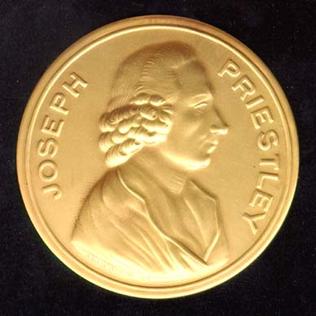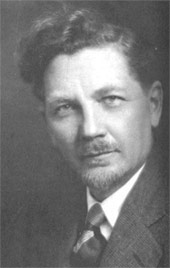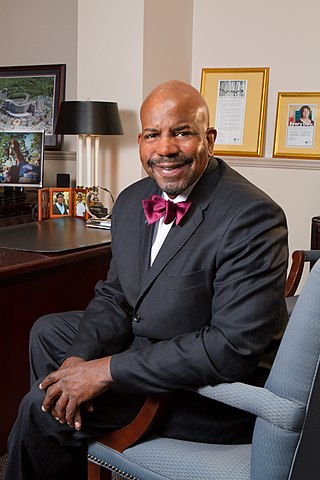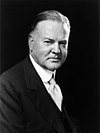Related Research Articles
The Henry Laurence Gantt Medal was established in 1929 by the American Management Association and the Management section of the American Society of Mechanical Engineers for "distinguished achievement in management and service to the community" in honour of Henry Laurence Gantt. By the year 1984 in total 45 medals had been awarded.

The Priestley Medal is the highest honor conferred by the American Chemical Society (ACS) and is awarded for distinguished service in the field of chemistry. Established in 1922, the award is named after Joseph Priestley, one of the discoverers of oxygen, who immigrated to the United States of America in 1794. The ACS formed in 1876, spearheaded by a group of chemists who had met two years previously in Priestley's home.

The Perkin Medal is an award given annually by the Society of Chemical Industry to a scientist residing in America for an "innovation in applied chemistry resulting in outstanding commercial development." It is considered the highest honor given in the US chemical industry.

The Timoshenko Medal is an award given annually by the American Society of Mechanical Engineers (ASME) to an individual "in recognition of distinguished contributions to the field of applied mechanics."
The American Institute of Mining, Metallurgical, and Petroleum Engineers (AIME) is a professional association for mining and metallurgy, with over 145,000 members. The association was founded in 1871 by 22 mining engineers in Wilkes-Barre, Pennsylvania, and was one of the first national engineering societies in the country.
The Daniel C. Drucker medal was instituted in 1997 by the Applied Mechanics Division of the American Society of Mechanical Engineers. The Drucker Medal is conferred in recognition of distinguished contributions to the fields of applied mechanics and mechanical engineering. The award is given in honor of Daniel C. Drucker, who was internationally known for contributions to the theory of plasticity and its application to analysis and design in metal structures. The recipient is given a medal and an honorarium.
The Washington Award is an American engineering award.
The Max Jakob Memorial Award recognizes an 'eminent scholarly achievement and distinguished leadership' in the field of heat transfer. Awarded annually to a scholar by the American Society of Mechanical Engineers (ASME) and the American Institute of Chemical Engineers (AIChE), it is the highest honor in the field of heat transfer these professional organizations bestow.
The American Society of Mechanical Engineers (ASME) established The Edwin F. Church Medal in 1972. Every year it is awarded to "an individual who has rendered eminent service in increasing the value, importance and attractiveness of mechanical engineering education." The ASME intends the Medal to represent Education in a very broad sense: This includes any aspect of mechanical engineering communicate via universities, technical institutes, professional society educational activities, continuing education programs of professional societies and private groups, in-house professional development programs of industrial concerns and governmental agencies, programmed learning and self-instruction systems. This means the nominees need not be professional educators.
The David W. Taylor Medal is a medal presented by the Society of Naval Architects and Marine Engineers for "notable achievement in naval architecture and/or marine engineering."
The ASME Medal, created in 1920, is the highest award bestowed by the ASME Board of Governors for "eminently distinguished engineering achievement". The award has been presented every year since 1996, and it consists of a $15,000 honorarium, a certificate, a travel supplement not to exceed $750, and a gold medal inscribed with the words, "What is not yet, may be".

Cato T. Laurencin FREng SLMH is an American engineer, physician, scientist, innovator and a University Professor of the University of Connecticut.
The George Westinghouse Medal is named for George Westinghouse and awarded to in honor of "eminent achievement or distinguished service in the power field of mechanical engineering" by the American Society of Mechanical Engineers. There is a Gold medal and a Silver medal. The silver medal may only be awarded to someone under 45 years of age.
The John Fritz Medal has been awarded annually since 1902 by the American Association of Engineering Societies (AAES) for "outstanding scientific or industrial achievements". The medal was created for the 80th birthday of John Fritz, who lived between 1822 and 1913. When AAES was dissolved in 2020, the administration of the Fritz medal was transferred to the American Institute of Mining, Metallurgical, and Petroleum Engineers (AIME), and is currently coordinated by AIME member society, the Society of Mining, Metallurgy, & Exploration (SME).
Jesse Lowen Shearer (1921—1992) was an American professor, engineer and pioneer in the field of hydraulics.
The Holley Medal is an award of ASME for "outstanding and unique act(s) of an engineering nature, accomplishing a noteworthy and timely public benefit by one or more individuals for a single achievement, provided the contributions are equal or comparable."

The William Lawrence Saunders Gold Medal was first awarded in 1927 and recognizes "distinguished achievement in mining other than coal". The award is funded by the American Institute of Mining, Metallurgical, and Petroleum Engineers and named for William Lawrence Saunders.

William Loren Batt was an American mechanical engineer, and president SKF Industries, Inc., awarded the Order of Vasa in 1923, the Henry Laurence Gantt Medal in 1940, and the Hoover Medal in 1951.

Conrad Newton Lauer was an American mechanical engineer, general manager at Day & Zimmerman, Inc., chairman of the Philadelphia Gas Works Co., and 51st president of the American Society of Mechanical Engineers in 1932–33.
Frank Kreith was an American mechanical engineer.
References
- ↑ "Hoover Medal". ASME. Retrieved 16 November 2015.
- ↑ "William Hammack Named 2020 Hoover Medalist". AIChE. September 1, 2020. Retrieved 2021-08-01.
- ↑ "Dr. Cato T. Laurencin Selected as 2021 Hoover Medalist". AIChE. July 26, 2021. Retrieved 2021-08-01.

